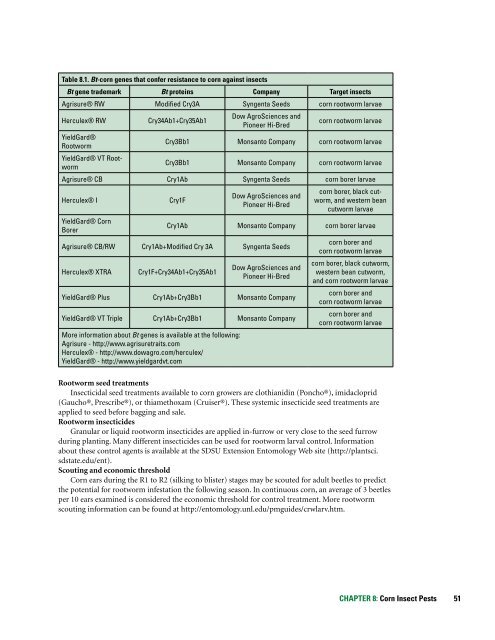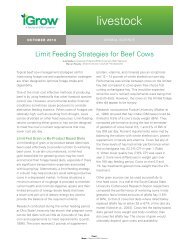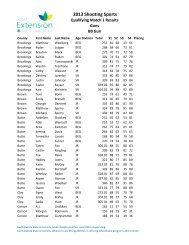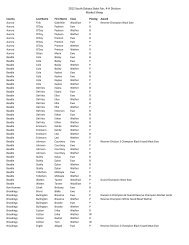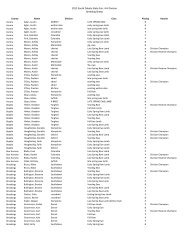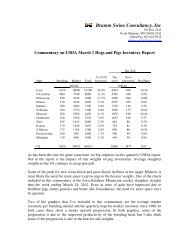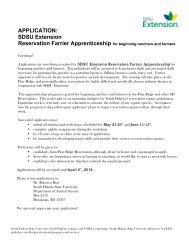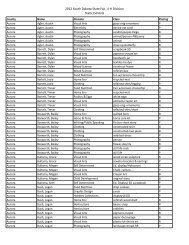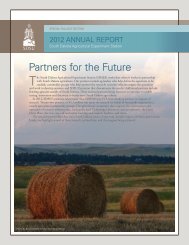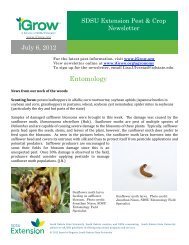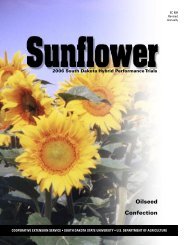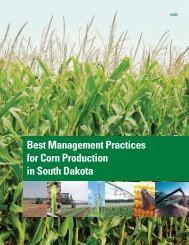Best Management Practices for Corn Production in South Dakota
Best Management Practices for Corn Production in South Dakota
Best Management Practices for Corn Production in South Dakota
You also want an ePaper? Increase the reach of your titles
YUMPU automatically turns print PDFs into web optimized ePapers that Google loves.
Table 8.1. Bt-corn genes that confer resistance to corn aga<strong>in</strong>st <strong>in</strong>sects<br />
Bt gene trademark Bt prote<strong>in</strong>s Company Target <strong>in</strong>sects<br />
Agrisure® RW Syngenta Seeds corn rootworm larvae<br />
<br />
<br />
Rootworm<br />
worm<br />
Dow AgroSciences and<br />
<br />
corn rootworm larvae<br />
corn rootworm larvae<br />
corn rootworm larvae<br />
Syngenta Seeds corn borer larvae<br />
<br />
<br />
Borer<br />
Dow AgroSciences and<br />
<br />
corn borer, black cutworm,<br />
and western bean<br />
cutworm larvae<br />
corn borer larvae<br />
Syngenta Seeds<br />
<br />
Dow AgroSciences and<br />
<br />
<br />
<br />
More <strong>in</strong><strong>for</strong>mation about Bt genes is available at the follow<strong>in</strong>g:<br />
Agrisure - http://www.agrisuretraits.com<br />
<br />
<br />
corn borer and<br />
corn rootworm larvae<br />
corn borer, black cutworm,<br />
western bean cutworm,<br />
and corn rootworm larvae<br />
corn borer and<br />
corn rootworm larvae<br />
corn borer and<br />
corn rootworm larvae<br />
Rootworm seed treatments<br />
Insecticidal seed treatments available to corn growers are clothianid<strong>in</strong> (Poncho®), imidacloprid<br />
(Gaucho®, Prescribe®), or thiamethoxam (Cruiser®). These systemic <strong>in</strong>secticide seed treatments are<br />
applied to seed be<strong>for</strong>e bagg<strong>in</strong>g and sale.<br />
Rootworm <strong>in</strong>secticides<br />
Granular or liquid rootworm <strong>in</strong>secticides are applied <strong>in</strong>-furrow or very close to the seed furrow<br />
dur<strong>in</strong>g plant<strong>in</strong>g. Many different <strong>in</strong>secticides can be used <strong>for</strong> rootworm larval control. In<strong>for</strong>mation<br />
about these control agents is available at the SDSU Extension Entomology Web site (http://plantsci.<br />
sdstate.edu/ent).<br />
Scout<strong>in</strong>g and economic threshold<br />
<strong>Corn</strong> ears dur<strong>in</strong>g the R1 to R2 (silk<strong>in</strong>g to blister) stages may be scouted <strong>for</strong> adult beetles to predict<br />
the potential <strong>for</strong> rootworm <strong>in</strong>festation the follow<strong>in</strong>g season. In cont<strong>in</strong>uous corn, an average of 3 beetles<br />
per 10 ears exam<strong>in</strong>ed is considered the economic threshold <strong>for</strong> control treatment. More rootworm<br />
scout<strong>in</strong>g <strong>in</strong><strong>for</strong>mation can be found at http://entomology.unl.edu/pmguides/crwlarv.htm.<br />
CHAPTER 8: <strong>Corn</strong> Insect Pests 51


